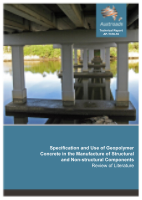Bridges

- Publication no: AP-T318-16
- ISBN: 978-1-925451-53-5
- Published: 15 December 2016
- PDF (free) Download
This report reviews published information on the formulation, manufacture and properties of geopolymer binders and concretes, to inform the manufacture of geopolymer concrete components for structural and non-structural bridge components and other road?related infrastructure.
The review shows that geopolymeric binders and concretes can be manufactured to produce products superior to Ordinary Portland Cement–based concrete (OPC concrete), particularly in relation to chemical attack on the matrix and fire resistance, but care needs to be taken in their manufacture.
The report details the factors to be considered in the selection of materials and manufacture of geopolymer concrete, noting that different applications require different formulations. These factors include the:
- nature of aluminosilicate source materials
- optimum Si/Al ratio of the precursor materials
- composition of the activating solution, and use of solid activators
- ratio of water/total solids (binder + alkali salts) and the ratio of activating solution/binder, and the effects of super-plasticisers
- effects of ambient curing and heat curing on strength development and drying shrinkage
- effects of starting materials on the nature of reaction products and their properties.
There is still inadequate data on the long-term mechanical and durability performance of geopolymer concrete. Future phases of this project will attempt to address these issues.
- Summary
- 1. Introduction
- 1.1. Purpose of Project
- 1.2. Definition of Geopolymer
- 1.3. Issue
- 1.4. Methodology
- 1.4.1. Dissemination Plan
- 2. Collection of Information from Local and Overseas Sources
- 2.1. Overseas Information
- 2.2. Local Information
- 2.2.1. Geopolymer Alliance
- 2.2.2. Zeobond
- 2.2.3. Road Agencies
- 2.2.4. Concrete Industry
- 2.2.5. Universities and CSIRO
- 2.2.6. Consultative Group
- 3. Review of Published Literature: Environmental Issues
- 4. Review of Published Literature: Technical Issues
- 4.1. What are Geopolymer Binders?
- 4.2. Ingredients Needed for Making Geopolymer Binder
- 4.2.1. Raw Materials
- 4.2.2. Alkali Activators
- 4.2.3. Sources of Materials in Australia
- 4.3. Mechanism of Geopolymer Formation
- 4.4. Factors Affecting the Geopolymerisation Reactions
- 4.5. Performance of the Geopolymer Materials
- 4.5.1. Metakaolin-based Geopolymers
- 4.5.2. Fly Ash-based Geopolymers
- 4.5.3. Slag-based Geopolymers – Alkali-activated Slag
- 4.5.4. Natural Pozzolans
- 4.5.5. Fresh Concrete Workability
- 4.5.6. Mechanical Properties
- 4.5.7. Drying Shrinkage
- 4.5.8. Bond Strength
- 4.5.9. Corrosion Problems
- 4.5.10. Carbonation
- 4.5.11. Sulfate and Acid Attack
- 4.5.12. Alkali-aggregate Reaction
- 4.5.13. Fire Resistance
- 4.5.14. Other Applications
- 4.6. ‘Just add water’ Concept
- 5. Summary, Conclusions and Experimental Phase
- 5.1. Positive Points Identified
- 5.2. Gaps in Information and Factors to be Investigated
- 5.2.1. Specification of Geopolymer Concrete
- 5.3. Experimental Phase of Project TS1835
- References
- Appendix A Geopolymer Formulations Compiled by Habert, d’Espinose de Lacaillerie and Roussel (2011) as found in the Literature
- Appendix B Parameters Used for Fly Ash-Based Geopolymer Concrete Mixes
- Appendix C Properties of Geopolymer Based Concrete
- Appendix D Responses Received from Consultative Group Members
